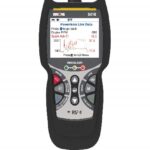Navigating car trouble can be daunting, especially when faced with error codes that seem cryptic. Among these, the P0651 Code is one that can cause confusion and concern. As your trusted expert from keyfobprog.com, I’m here to demystify this code, offering clear insights and guidance to help you understand and address the issue effectively.
What Does the P0651 Code Mean?
The P0651 code, in technical terms, indicates a problem with the “Sensor Reference Voltage ‘B’ Circuit/Open.” In simpler language, this means your car’s computer, the Engine Control Module (ECM) or Powertrain Control Module (PCM), has detected an issue within a specific 5-volt reference circuit. This 5-volt circuit is crucial as it supplies power to a variety of sensors that monitor different engine and vehicle operations. These sensors are essential for your car to run efficiently and effectively. When the ECM detects an open or short in the ‘B’ reference voltage circuit, it triggers the P0651 code.
Symptoms Associated with P0651 Code
When the P0651 code appears, you might notice several symptoms affecting your vehicle’s performance:
- Check Engine Light is illuminated: This is the most immediate sign, alerting you to a problem detected by the car’s computer.
- Rough Engine Performance: The engine may run unevenly, hesitate, or stall. This is because the sensors relying on the faulty 5V reference circuit are providing inaccurate data, disrupting the engine’s optimal operation.
- Reduced Fuel Efficiency: Inaccurate sensor readings can lead to inefficient fuel combustion, causing you to use more fuel than usual.
- Possible Stalling: In severe cases, the engine might stall, especially at idle, due to the disrupted sensor signals.
- Other Diagnostic Trouble Codes (DTCs): P0651 often appears alongside other codes related to specific sensors that share the same ‘B’ reference circuit. These might include codes for throttle position sensor, manifold absolute pressure (MAP) sensor, or oxygen sensors.
Potential Causes of P0651 Code
Several factors can trigger the P0651 code. Pinpointing the exact cause is crucial for effective repair. Here are some common culprits:
- Faulty Sensor: One of the most common reasons is a failure in a sensor that uses the ‘B’ 5-volt reference circuit. This could be a MAP sensor, throttle position sensor, or another sensor depending on your vehicle’s make and model.
- Wiring Issues: Problems in the wiring harness, such as shorts, open circuits, or corrosion, can disrupt the 5-volt reference signal. This is a frequent cause, especially in areas exposed to harsh conditions or engine heat.
- Connector Problems: Loose or corroded connectors at the sensor or ECM can interrupt the circuit, leading to a P0651 code.
- ECM/PCM Failure (Less Likely): While less common, the ECM or PCM itself could be faulty. Internal issues within the computer can cause it to incorrectly detect or generate the 5-volt reference signal. However, this is often diagnosed after ruling out other possibilities.
Diagnosing and Troubleshooting P0651 Code
Troubleshooting the P0651 code requires a systematic approach. Here’s a general process you or a mechanic might follow:
- Scan for Codes: Use an OBD-II scanner to confirm the P0651 code and check for any other related codes. This provides a starting point for diagnosis.
- Inspect Wiring and Connectors: Carefully examine the wiring and connectors associated with the ‘B’ 5-volt reference circuit. Look for signs of damage, corrosion, or loose connections. Pay close attention to the sensors that share this circuit.
- Check Sensor Voltage: Use a multimeter to test the 5-volt reference voltage at the sensor connector. A lack of voltage or unstable voltage indicates a problem in the circuit.
- Isolate the Faulty Sensor: If multiple sensors share the ‘B’ circuit, you may need to disconnect them one by one, while monitoring the voltage and checking if the code clears. This helps identify if a specific sensor is causing the issue by shorting the circuit.
- ECM/PCM Testing (Advanced): If wiring and sensors check out, the ECM/PCM might be suspected. Testing the ECM/PCM often requires specialized equipment and should be performed by a qualified technician.
Seeking Professional Help
While some basic checks can be done at home, diagnosing P0651 effectively often requires professional expertise. A qualified mechanic will have the right tools and knowledge to pinpoint the exact cause, whether it’s a faulty sensor, wiring problem, or a rare ECM issue.
When you take your vehicle to a repair shop or dealership, it’s wise to be informed. Ask if they perform “diagnostic troubleshooting.” A shop with diagnostic capabilities should possess scan tools to read sensor voltages and signal patterns, crucial for P0651 diagnosis. Inform them of any troubleshooting steps you’ve already taken. This demonstrates your engagement and can streamline the diagnostic process.
Be cautious of workshops immediately suggesting an ECM replacement. While ECM issues are possible, they are less frequent than sensor or wiring problems. As mentioned in our experience at keyfobprog.com, some less scrupulous places might jump to ECM replacement as it can be a more expensive service. Ensure they thoroughly check sensors and wiring before considering ECM replacement. A competent technician should verify the 5-volt circuit and sensor conditions before declaring the ECM faulty. Always ask for a detailed diagnosis and estimate before authorizing extensive repairs.
And remember, part costs can vary dramatically. For instance, a secondary valve (like part number 12619109 mentioned earlier) might be significantly cheaper from online retailers like RockAuto compared to dealership prices. Being aware of these price differences can help manage your repair expenses.
Understanding the P0651 code and following a logical diagnostic approach can save you time and money. Whether you are a DIY enthusiast or prefer professional help, being informed empowers you to handle car issues more confidently.
